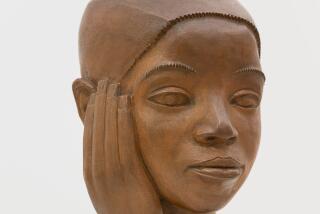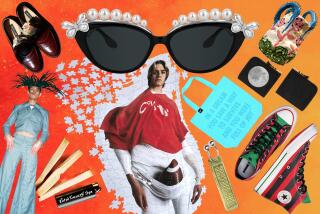Gallery Tunes In on Work of Black Artists : Art: Capitalizing on âThe Cosby Showâ-inspired popularity of black works, Melvin Summers opened a shop in Pomona. He hopes to help unknown artists.
Former tire store manager Melvin Summersâ dream of owning a black art gallery came true with the flip of a television dial and the help of one of Americaâs favorite small-screen families, the Huxtables of âThe Cosby Show.â
No, Bill Cosby did not finance or endorse Summersâ Pomona gallery, the Ebony Music and Art center. But when Cosby began decorating the Huxtable living room with paintings by black artists, America began to tune in to the African-American art phenomenon.
Soon, in some circles at least, the work of painter Ellis Wilson became as famous as the tapestry-patterned sweaters Cosby wears on the show. A Cosby episode was built around a Wilson painting called âThe Funeral Procession,â a print of which is on display at Ebony.
âThis is art that blacks can identify with. They can see themselves in these images,â said Summers, who says his Ebony gallery is unique in the San Gabriel Valley. He opened the gallery two years ago, capitalizing on the television-inspired popularity that led to black artistsâ works being sold at swap meets and then at home shows similar to Tupperware parties.
Black artists have been around for centuries, but they have had little recognition in the mainstream art gallery network, said Lizzetta LeFalle-Collins, curator of visual arts at the Los Angeles Afro-American Museum in Exposition Park.
âThese artists went unnoticed until more blacks in the (art) field began to write about them and promote their work,â LeFalle-Collins said. âAlso, with American art getting more and more expensive, art collectors and dealers are always looking for the unfound artist.â
Summers, 52, of Upland, hopes to launch a few of these unfound black masters.
From his shopping center storefront, he sells limited-edition prints and artistsâ proofs from both undiscovered and nationally known black artists. The prints include works by Ernie Barnes, Walt Walker, Paul Njalamba, Albert Mukasa Wilson and Herb Jeffries. He also sells art objects and cultural artifacts from nine African nations.
Summers also sells black popular music and gospel, which he admits is mainly a way to bring foot traffic into his 1,300-square-foot gallery.
âWeâre the only store of this kind in the area outside of downtown Los Angeles,â Summers said. âIt was a risk opening this place--a big risk. But weâre beginning to attract the clientele weâre after.â
Summers, a native of St. Louis, always had an interest in art, but that love stayed dormant while he worked as a manager with the Mark C. Bloome tire company. It took a trip to Paris 3 1/2 years ago to rekindle the spark.
âI just went wild in the Louvre,â Summers said. âIt was incredible to be that close to the Mona Lisa and Venus de Milo.â Since then, he has spent much of his spare time reading up on art, meeting artists and learning all he can about the techniques used in various art media.
Two years ago, Summers and his wife, Aliitasi, decided to fulfill their dream, choosing the Pomona location because they would not have any local competition and because of its proximity to booming new communities like Phillips Ranch.
Most of his customers are black--about 95%, he said. âThey like the fact that they can see themselves in the work,â Summers explained.
However, the personal connection with the work can sometimes work against a sale. One customer, he said, stared at a print of a nightclub singer for a full five minutes before she rejected it. âThat lady looks just like a lady I knew in Kansas City that I couldnât stand,â the potential buyer announced before she turned on her heel.
Each piece of art, whether it features African scenes or black Americans, makes its own statement, said Alma Derritt, a customer of Summers who began collecting black art a few years ago. âAs a black female, I can purchase a piece of art that will be a part of my heritage and that I can pass on to my children and my grandchildren,â she said.
The storeâs merchandise sells for between $30 and $1,500, so Derritt said she purchases the pieces sparingly and considers them investments.
Part of the pleasure of shopping at Ebony, Derritt said, is drawing on Summersâ familiarity with the works of artists in the collection. âEvery time he gives me a piece of information on a particular work, he just glows,â she said.
Summersâ goal is to make art available to the average person. By selling prints signed and numbered by the artists, rather than lithographs or originals, he keeps the cost down. He also offers a layaway plan.
Artist Charles A. Bibbs, who recently held a show at Summersâ gallery, said stores like Summersâ are a way of getting the art out to the people it was designed for--much as Cosbyâs television program showcases black artistsâ work.
âAs black society gets more into the finer things in life, their status in society increases,â Bibbs said. âIn the past, it was fashionable only for the rich to collect art. Now weâre creating positive role models on TV and in the media and weâre giving our community something to be proud of.â
Klein is a regular contributor to San Gabriel Valley View.
More to Read
The biggest entertainment stories
Get our big stories about Hollywood, film, television, music, arts, culture and more right in your inbox as soon as they publish.
You may occasionally receive promotional content from the Los Angeles Times.










